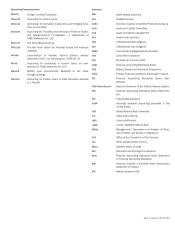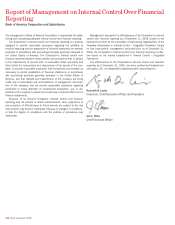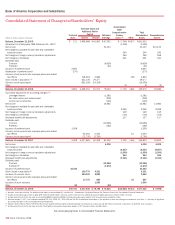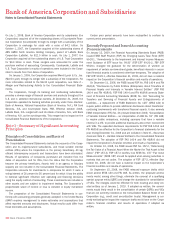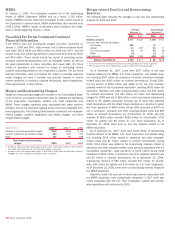Bank of America 2008 Annual Report Download - page 125
Download and view the complete annual report
Please find page 125 of the 2008 Bank of America annual report below. You can navigate through the pages in the report by either clicking on the pages listed below, or by using the keyword search tool below to find specific information within the annual report.ration discontinues hedge accounting when it is determined that a
derivative is not expected to be or has ceased to be highly effective as a
hedge, and then reflects changes in fair value of the derivative in earn-
ings after termination of the hedge relationship.
The Corporation uses its derivatives designated as hedging for
accounting purposes as either fair value hedges, cash flow hedges or
hedges of net investments in foreign operations. The Corporation man-
ages interest rate and foreign currency exchange rate sensitivity predom-
inantly through the use of derivatives. Fair value hedges are used to
protect against changes in the fair value of the Corporation’s assets and
liabilities that are due to interest rate or foreign exchange volatility. Cash
flow hedges are used to minimize the variability in cash flows of assets or
liabilities, or forecasted transactions caused by interest rate or foreign
exchange fluctuation. For terminated cash flow hedges, the maximum
length of time over which forecasted transactions are hedged is 27 years,
with a substantial portion of the hedged transactions being less than 10
years. For open or future cash flow hedges, the maximum length of time
over which forecasted transactions are or will be hedged is less than
seven years. Changes in the fair value of derivatives designated as fair
value hedges are recorded in earnings, together and in the same income
statement line item with changes in the fair value of the related hedged
item. Changes in the fair value of derivatives designated as cash flow
hedges are recorded in accumulated other comprehensive income (OCI)
and are reclassified into the line item in the Consolidated Statement of
Income in which the hedged item is recorded in the same period the
hedged item affects earnings. Hedge ineffectiveness and gains and
losses on the excluded component of a derivative in assessing hedge
effectiveness are recorded in earnings in the same income statement line
item that is used to record hedge effectiveness. SFAS 133 retains certain
concepts of SFAS No. 52, “Foreign Currency Translation,” (SFAS 52) for
foreign currency exchange hedging. Consistent with SFAS 52, the Corpo-
ration records changes in the fair value of derivatives used as hedges of
the net investment in foreign operations, to the extent effective, as a
component of accumulated OCI.
If a derivative instrument in a fair value hedge is terminated or the
hedge designation removed, the previous adjustments to the carrying
amount of the hedged asset or liability are subsequently accounted for in
the same manner as other components of the carrying amount of that
asset or liability. For interest-earning assets and interest-bearing
liabilities, such adjustments are amortized to earnings over the remaining
life of the respective asset or liability. If a derivative instrument in a cash
flow hedge is terminated or the hedge designation is removed, related
amounts in accumulated OCI are reclassified into earnings in the same
period or periods during which the hedged forecasted transaction affects
earnings. If it is probable that a forecasted transaction will not occur, any
related amounts in accumulated OCI are reclassified into earnings in that
period.
Interest Rate Lock Commitments
The Corporation enters into IRLCs in connection with its mortgage bank-
ing activities to fund residential mortgage loans at specified times in the
future. IRLCs that relate to the origination of mortgage loans that will be
held for sale are considered derivative instruments under SFAS No. 149,
“Amendment of Statement 133 on Derivative Instruments and Hedging
Activities.” As such, these IRLCs are recorded at fair value with changes
in fair value recorded in mortgage banking income.
Effective January 1, 2008, the Corporation adopted SAB 109 for its
derivative loan commitments issued or modified after the adoption date
which supersedes SEC SAB No. 105, “Application of Accounting Princi-
ples to Loan Commitments,” (SAB 105). SAB 109 requires that the
expected net future cash flows related to servicing of a loan be included
in the measurement of all written loan commitments that are accounted
for at fair value through earnings. In estimating the fair value of an IRLC,
the Corporation assigns a probability to the loan commitment based on
an expectation that it will be exercised and the loan will be funded. The
fair value of the commitments is derived from the fair value of related
mortgage loans which is based on observable market data. Changes to
the fair value of IRLCs are recognized based on interest rate changes,
changes in the probability that the commitment will be exercised and the
passage of time. Changes from the expected future cash flows related to
the customer relationship are excluded from the valuation of the IRLCs.
Prior to January 1, 2008, the Corporation did not record any unrealized
gain or loss at the inception of the loan commitment, which is the time
the commitment is issued to the borrower, as SAB 105 did not allow
expected net future cash flows related to servicing of a loan to be
included in the measurement of all written loan commitments that are
accounted for at fair value through earnings.
Outstanding IRLCs expose the Corporation to the risk that the price of
the loans underlying the commitments might decline from inception of the
rate lock to funding of the loan. To protect against this risk, the Corpo-
ration utilizes forward loan sales commitments and other derivative
instruments, including interest rate swaps and options, to economically
hedge the risk of potential changes in the value of the loans that would
result from the commitments. The changes in the fair value of these
derivatives are recorded in mortgage banking income.
Securities
Debt securities are classified based on management’s intention on the
date of purchase and recorded on the Consolidated Balance Sheet as
debt securities as of the trade date. Debt securities which management
has the intent and ability to hold to maturity are classified as
held-to-maturity and reported at amortized cost. Debt securities that are
bought and held principally for the purpose of resale in the near term are
classified as trading account assets and are stated at fair value with
unrealized gains and losses included in trading account profits (losses).
All other debt securities that management has the intent and ability to
hold for the foreseeable future are classified as available-for-sale (AFS)
and carried at fair value with net unrealized gains and losses included in
accumulated OCI on an after-tax basis. If there is an other-than-temporary
deterioration in the fair value of any individual debt security classified as
AFS, the Corporation will reclassify the associated net unrealized loss out
of accumulated OCI with a corresponding adjustment to other income. If
there is an other-than-temporary deterioration in the fair value of any
individual security classified as held-to-maturity the Corporation will write
down the security to fair value with a corresponding adjustment to other
income. Interest on debt securities, including amortization of premiums
and accretion of discounts, is included in interest income. Realized gains
and losses from the sales of debt securities, which are included in gains
(losses) on sales of debt securities, are determined using the specific
identification method.
Marketable equity securities are classified based on management’s
intention on the date of purchase and recorded on the Consolidated
Balance Sheet as of the trade date. Marketable equity securities that are
bought and held principally for the purpose of resale in the near term are
classified as trading account assets and are stated at fair value with
unrealized gains and losses included in trading account profits (losses).
Other marketable equity securities that management has the intent and
ability to hold for the foreseeable future are accounted for as AFS and
classified in other assets. All AFS marketable equity securities are carried
at fair value with net unrealized gains and losses included in accumulated
OCI on an after-tax basis. If there is an other-than-temporary deterioration
in the fair value of any individual AFS marketable equity security, the
Bank of America 2008
123


